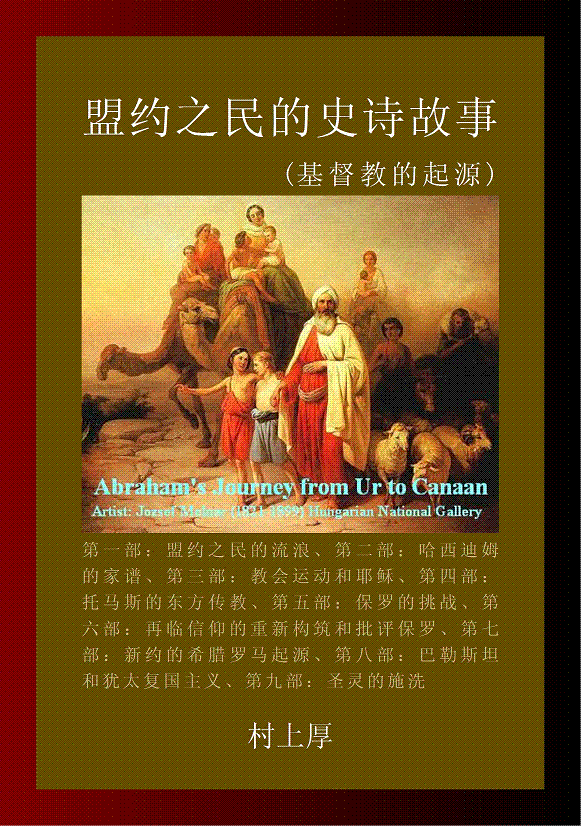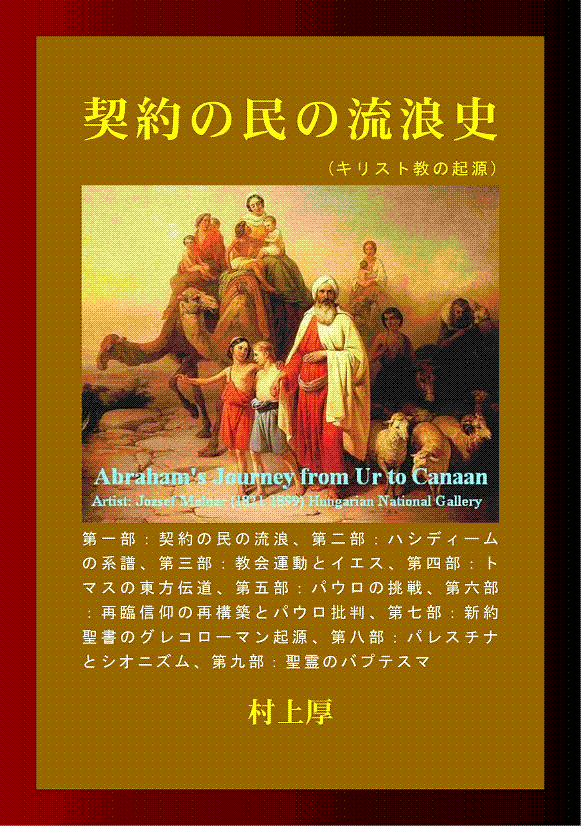
An Epic Tale of the People of the Covenant (The origin of Christianity)
New issue: the PDF versions of "An Epic Tale of the People of the Covenant (The origin of Christianity)" in English, Japanese and Chinese editions are now available on Google Play website in 66 countries around the world, and the ePub versions of Japanese and English editions are on Amazon website in 13 countries. All prices are worth US $ 4. Please visit the nearest site and purchase in your favorite currency.

[Preface] In the region from Mesopotamia situated within the Tigris–Euphrates river to Palestine, city states, where agricultural and nomadic people had lived together, have risen and fallen since ancient times. The agricultural people played leading role in the most of these city states. However, the nomads traded not only with Egypt in the west but also with India and China in the east and served as catalysts for cross-cultural fusion.
These nomads include not only tribes of Reuben, Simeon, Levi, Judah, Zebulun, Issachar, Dan, Gad, Asher, Naphtali, Joseph and Benjamin, who have cultural backgrounds of Mesopotamia and Egypt, but also Manasseh and Ephraim, who have the Y chromosome gene D, which is characteristic of the Tibetans and the Jomon people (縄文人), the indigenous people of the Japanese archipelago, and seem to have been belonged to the Paleo-Mongoloids. They had also believed in different patron gods. But they formed a union of independent tribes and established the unity of religion and politics based on the covenant of the single founder Abraham and God from 3,000 to 4,000 years ago in Palestine region and appeared on history's center stage replacing agricultural people. Thus the People of the Covenant was born.
Though Judaism was originally an exclusive and introvert religion, as the twelve tribes of Israel incorporated the extroverted and harmonious Ephraim and Manasseh tribes of Paleo-Mongoloid, Judaism and Christianity were propagated to not only the Mediterranean region, but also to Central Asia, India, China, and even Japanese archipelago. Moreover, Jingjiao (景教Luminous Religion), which is considered to be the origin of the Oriental Christian churches, played a role as a catalyst for the birth of Islam and the Mahayana Buddhist movement. As a result, the total number of the People of the Covenant, that is, Judaism, Christianity and Islam, is said to be 3.4 billion now.
[9]A thread of fate binding between St. Thomas' Mission to Beijing and Wa-koku (倭国)

According to Protestant Bible commentator Mr. Arimasa Kubo, who was the first pastor of the Ikebukuro-Nishi Church, The United Church of Christ in Japan, St. Thomas traveled to Assyria around 35 C.E., two years after Jesus' ascension, and went on a mission to India, and then evangelized to China via Tibet, reached the present Beijing (北京) in 62 C.E., and seems to have established an organized church (congregation), too. By the way, why did Thomas go to the northern frontier town called Ji Xian (薊県), but not Luo Yang (洛陽) or Chang An (長安), capital cities of the later Han (后漢)? Apostles at that time, whether Paul or John, all preached to areas where a Jewish community already existed, and it is probable that there was also a Jewish community in Beijing at that time.
Come to think of it, on the monument of 'Reconstruction of the Temple of Purity and Truth (重建清真寺記碑)' discovered in Kaifeng city (開封市) of eastern Henan province (河南省) of China, it is said to be written that the Jews first arrived in the city in 231 BC, when General Ben Wang (王賁) of Qin (秦) reduced Wei (魏)'s capital city, Daliang (大梁: current Kaifeng City), and formed a Jewish community. Almost ten years later, in 226 BC, General Ben Wang reduced Yan (燕)'s royal capital, Jicheng (薊城, now the city of Beijing), and Kingdom of Yan was extinguished in 222 BC.
Seen as the mother tribe of Qin (秦), the Qiang (羌) tribe was literally herders that grazed sheep, and was a typical descendants of Manasseh, according to Israeli research agency Amishav, organisation aimed at seeking the Lost Tribes of Israel.
Therefore, there seems to have been Jewish mercenary units which took put in various battles directly under General Ben Wang and communities of families of these mercenary units might have formed in the area where the General was to battle.
Incidentally, China's oldest geography book, "Shanhaijing (山海経: Mountain and Sea sutra)," written during the Spring and Autumn Warring States period (春秋戦国時代) to the Qin-Han era (秦漢時代), states that "The country of Gai (蓋) lies south of Yan (燕) and north of Wo (倭 = Wa in Japanese), and Wo belongs to Yan." This is the first example of "Wo (倭)" appearing in Chinese books. Apparently, "Wo (倭)" seems to have been regarded as a part of "Yan (燕)" around the time from the Spring and Autumn Warring States period to the Qin-Han era. If so, when St. Thomas visited former Yan (燕)'s royal capital Jicheng (薊城), the Jewish community there might have had a close relationship with Yamato Kingdom (大和国), which Nigihayahinomikoto (饒速日尊) had established under the cooperation of the Jewish tribe Ephraim, and Hata clan (秦氏), which was descendants of the Manasseh tribe and had been naturalized in Yamato in the Emperor Ojin (応神天皇)'s reign. (Later mention)

While the descriptions in the Nihon Shoki (日本書紀) and Kojiki (古事記) imply that the Japanese imperial family has blood relations with both Silla (新羅) and Baekje (百済) and it appears that the Ephraim and Manasseh tribes of the ten lost tribes of Israel seem to have acted as mediators of them.
Because when Nigihayahinomikoto (饒速日尊) descended in Kinki region (畿地方) first, he called his country Yamato kingdom (大和王国) based on the Aramaic word 'Yehoamato', which means 'Yahweh's people' in order to show themselves as the tribe of Tenson (天孫族Imperial ancestors descended from Heaven), residents of the Japanese archipelago including Jomon people (縄文人) began to call themselves Yamato, and it became the national title of the Yamataikoku (邪馬台国) that was born after that.
When the General of the Eastern expedition of Kitakyushu based Korean Peninsula-linked clan (Iwai磐井?) vanquished the Kinki region (近畿地方), he inherited the name of the Yamato kingdom and called himself Kamu-yamato-iware-hiko no Mikoto (神日本磐余彦尊), which is derived from the Hebrew-Aramaic words 'Kam Yamato Ephraim Peko Shmelon Makto' and can be interpreted as 'The king of Samaria, the noble founder of the Ephraim tribe of Yahweh.' These suggest that Nigihayahinomikoto established the Yamato kingdom with the cooperation of the Jewish tribe Ephraim, and Emperor Jimmu (神武天皇) also inherited that tradition.
On the other hand, it seems that the tribe in Kitakyushu, led by Emperor Jimmu (神武天皇)'s older brother Inainomikoto (稲飯命), later founded Silla (新羅) on the Korean Peninsula. However, both Yamataikoku (邪馬台国) and Yamato Kingdom (大和王権) often dispatched troops to Silla (新羅), taking a diplomatic stance supporting Baekje (百済). In the Emperor Ojin 's reign, the Emperor sent troops to Korean Peninsula twice to realize the arrival of King of Yuzuki (弓月君), who is said to have been the third generation grandson of Qin Shi Huang (秦始皇帝BC259-BC210) and also the ancestor of Hata clan (秦氏) and to have led the people of 120 prefectures and have requested naturalization as Yamato citizens but have been stuck in Kala (加羅) after being disturbed by Silla (新羅). According to the Israeli research agency Amishav, Hata clan seems to have been the descendants of the tribe Manasseh. If the description in "Honchokouinshounroku (本朝皇胤紹運録)" is correct, the current royal family, which belongs to Emperor Keitai's direct line, is likely to be the descendants of the Manasseh tribe.
Purchase here